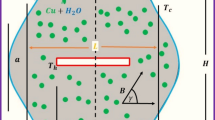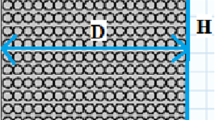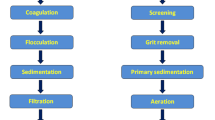Abstract
Computational Fluid Dynamics (CFD) is widely used in different industrial applications. In this research, the application of CFD in the thermo-hydraulic evaluation for a typical small modular Pressurized Water Reactor (PWR) was studied using ANSYS Fluent software. First, reactor core with different (pitch—fuel rod diameter) was simulated using MCNP code. Subsequently, axial neutron heat flux was calculated in the hottest rod. In the following, different fuel channels were simulated using ANSYS workbench and corresponding mass flow rate according to the fluid outlet temperature was computed using Fluent. Then, thermo-hydraulic parameters including pumping power, convective heat transfer coefficient and turbulent intensity were calculated. Artificial neural network (ANN) coupled with genetic algorithm (GA) was used for optimization; and pair pitch ‒ fuel rod diameter (0.012 m, 0.0072 m) was selected as the optimum value. Also, Critical Heat Flux (CHF) was computed with CFD-simulation, and compared with Tong CHF correlation and Groeneveld look-up table. A good agreement was observed between results, but CHF obtained from CFD simulation was more conservative. According to the results, Minimum Departure from Nucleate Boiling Ratio (MDNBR) was obtained as 2.12, which was compatible with its typical value. Accordingly, it could be concluded that the optimum reactor core was in the safe mode in the steady state conditions.









Similar content being viewed by others
Notes
The pumping power is the power required to overcome the pressure drop in the primary loop by the coolant.
REFERENCES
R. Meroney, R. Ohba, B. Leitl, H. Kondo, D. Grawe, and T. Yoshihide, “Review of CFD guidelines for dispersion modeling,” Fluids 1, 14 (2016). https://doi.org/10.3390/fluids1020014
M. L. Hosain and R. B. Fdhilaa, “Literature review of accelerated CFD simulation methods towards online application,” Energy Procedia 75, 3307–3314 (2015). https://doi.org/10.1016/j.egypro.2015.07.714
H. Farajollahi, A. Ghasemizad, and B. Khanbabaei, “CFD-calculation of fluid flow in a pressurized water reactor,” J. Sci. I. R. Iran 19, 273–281 (2008).
Y. V. Yudov, I. G. Petkevich, and V. G. Artemov, “Cross-verification of 1D and 3D models for a VVER-1000 reactor’s pressure chamber simulated by the KORSAR/CFD computation code in the modes with asymmetric loop operation,” Therm. Eng. 66, 953–959 (2019). https://doi.org/10.1134/S0040601519120115
N. Ebrahimian and G. R. Ansarifar, “Investigation of the nano fluid effects on heat transfer characteristics in nuclear reactors with dual cooled annular fuel using CFD (computational fluid dynamics) modeling,” Energy 98, 1–14 (2016). https://doi.org/10.1016/j.energy.2016.01.005
Advances in Small Modular Reactor Technology Developments (International Atomic Energy Agency, Vienna, Austria, 2018).
S. F. Mirian and N. Ayoobian, “Investigations on a typical small modular PWR using coupled neutronic-thermal-mechanical evaluations to achieve long-life cycle-length,” Prog. Nucl. Energy 119, 103176 (2020). https://doi.org/10.1016/j.pnucene.2019.103176
R. Kianpoor and G. R. Ansarifar, “Assessment of the nano-fluid effects on the thermal reactivity feedback coefficients in the VVER-1000 nuclear reactor with nanofluid as a coolant using thermal hydraulic and neutronics analysis,” Ann. Nucl. Energy 133, 623–636 (2019). https://doi.org/10.1016/j.anucene.2019.07.002
FLUENT 6.3 User’s Guide (Fluent, 2006).
T. Sreenivasulu and B. V. S. S. S. Prasad, “Flow and heat transfer characteristics in an annulus wrapped with a helical wire,” Int. J. Therm. Sci. 48, 1377–1391 (2009). https://doi.org/10.1016/j.ijthermalsci.2008.11.023
M. Zaidabadi, G. R. Ansarifar, and M. H. Esteki, “Thermal hydraulic analysis of VVER-1000 nuclear reactor with dual-cooled annular fuel using K-ω SST Turbulence model,” Ann. Nucl. Energy 101, 118–127 (2017). https://doi.org/10.1016/j.anucene.2016.09.027
J. Weisman, “Heat transfer to water flowing parallel to tube bundles,” Nucl. Sci. Eng. 6, 78–79 (1959). https://doi.org/10.13182/NSE59-A25631
M. M. El-Wakil, Nuclear Heat Transport (American Nuclear Society, La Grange Park, Ill., 1978).
ANSYS FLUENT 12.0 User’s Guide (ANSYS, 2009). https://www.afs.enea.it/project/neptunius/docs/fluent/ html/ug/main_pre.htm
E. Alba and J. F. Chicano, “Training neural networks with GA hybrid algorithms,” in Proc. Genetic and Evolutionary Computation Conf. (GECCO 2004), Seattle, Wash., June 26–30, 2004 (Springer-Verlag, Berlin, 2004), in Ser.: Lecture Notes in Computer Science, Vol. 3102, pp. 852–863. https://doi.org/10.1007/978-3-540-24854-5_87
H. Ishibuchi, T. Nakashima, and M. Nii, “Learning of neural networks with GA-based instance selection,” in Proc. Joint 9th IFSA World Congr. and 20th NAFIPS Int. Conf., Vancouver, B.C., Canada, July 25–28, 2001 (IEEE, Piscataway, N.J., 2002). https://doi.org/10.1109/NAFIPS.2001.944394
R. Kianpoor, G. R. Ansarifar, and M. Fathi, “Optimal design of a VVER-1000 nuclear reactor core with dual cooled annular fuel based on the reactivity temperature coefficients using thermal hydraulic and neutronic analysis by implementing the genetic algorithms,” Ann. Nucl. Energy 148, 107682 (2020). https://doi.org/10.1016/j.anucene.2020.107682
S. M. H. Mousakazemi, N. Ayoobian, and G. R. Ansarifar, “Control of the reactor core power in PWR using optimized PID controller with the real-coded GA,” Ann. Nucl. Energy 118, 107–121 (2018). https://doi.org/10.1016/j.anucene.2018.03.038
N. E. Todreas and M. S. Kazimi, Nuclear Systems, Vol. I: Thermal Hydraulic Fundamentals, 2nd ed. (CRC, Boca Raton, Fla., 2011).
P. K. Sarma, V. Srinivas, K. V. Sharma, V. Dharma Rao, and G. P. Celata, “A correlation to evaluate critical heat flux in small diameter tubes under subcooled conditions of the coolant,” Int. J. Heat Mass Transfer 49, 42–51 (2006). https://doi.org/10.1016/j.ijheatmasstransfer.2004.07.052
D. C. Groeneveld, L. K. H. Leung, Y. Guo, A. Vasic, M. El Nakla, S. W. Peng, J. Yang, and S. C. Cheng, “Lookup tables for predicting CHF and film-boiling heat transfer: Past, present, and future,” Nucl. Tech. 152, 87–104 (2005). https://doi.org/10.13182/NT152-87
Author information
Authors and Affiliations
Corresponding author
Rights and permissions
About this article
Cite this article
Mirian, S.F., Ayoobian, N. Thermo-Hydraulic Investigations of a Typical Small Modular PWR Using Computational Fluid Dynamics Modelling. Therm. Eng. 68, 922–929 (2021). https://doi.org/10.1134/S0040601521120077
Received:
Revised:
Accepted:
Published:
Issue Date:
DOI: https://doi.org/10.1134/S0040601521120077




